-
 Bitcoin
Bitcoin $82,532.5653
-0.47% -
 Ethereum
Ethereum $1,824.2400
-0.22% -
 Tether USDt
Tether USDt $1.0002
0.04% -
 XRP
XRP $2.0891
-2.87% -
 BNB
BNB $598.7668
-1.02% -
 Solana
Solana $125.5207
0.59% -
 USDC
USDC $0.9999
-0.03% -
 Dogecoin
Dogecoin $0.1644
-3.47% -
 Cardano
Cardano $0.6468
-4.11% -
 TRON
TRON $0.2341
1.48% -
 Toncoin
Toncoin $3.9443
3.93% -
 Chainlink
Chainlink $13.3725
-2.17% -
 UNUS SED LEO
UNUS SED LEO $9.1022
-5.82% -
 Stellar
Stellar $0.2658
-0.94% -
 Avalanche
Avalanche $18.7494
-2.83% -
 Shiba Inu
Shiba Inu $0.0...01225
-3.10% -
 Sui
Sui $2.2404
-5.15% -
 Hedera
Hedera $0.1615
-5.38% -
 Polkadot
Polkadot $4.0239
-1.65% -
 Litecoin
Litecoin $82.5262
-3.94% -
 MANTRA
MANTRA $6.2971
-0.12% -
 Bitcoin Cash
Bitcoin Cash $300.5206
-2.01% -
 Dai
Dai $0.9999
-0.01% -
 Bitget Token
Bitget Token $4.4612
-3.72% -
 Ethena USDe
Ethena USDe $1.0000
0.00% -
 Pi
Pi $0.7041
-8.37% -
 Hyperliquid
Hyperliquid $12.6570
0.20% -
 Monero
Monero $216.6236
0.33% -
 Uniswap
Uniswap $5.9290
-0.81% -
 Aptos
Aptos $5.3023
0.05%
How is "mining difficulty" of blockchain adjusted?
Mining difficulty adjusts to maintain stable block times, ensuring blockchain security and influencing miner profitability based on network hash rate changes.
Mar 29, 2025 at 06:50 am
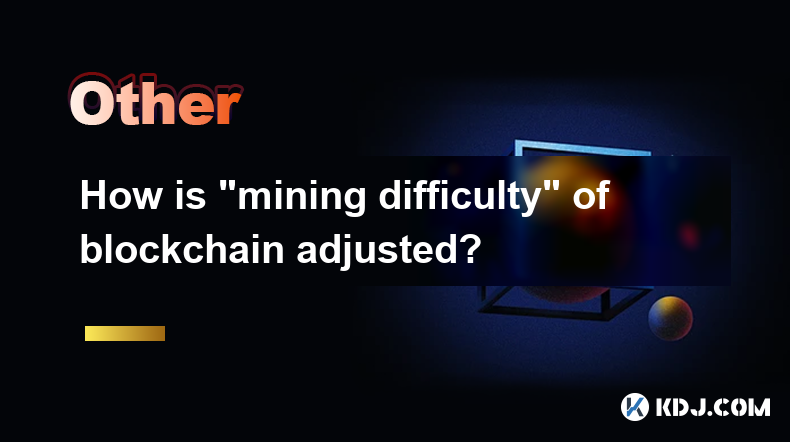
Understanding Blockchain Mining Difficulty
The mining difficulty of a blockchain is a crucial mechanism that maintains the security and stability of the network. It essentially represents how computationally difficult it is to successfully mine a new block and add it to the blockchain. This difficulty dynamically adjusts to ensure that new blocks are added at a relatively consistent rate, regardless of the overall network hash rate. This rate is pre-determined and hard-coded into the blockchain's protocol. A higher difficulty means more computational power is needed to solve the cryptographic puzzle and earn rewards.
The Purpose of Difficulty Adjustment
The primary purpose of adjusting mining difficulty is to maintain a stable block generation time. If the network hash rate (the total computational power dedicated to mining) increases significantly, blocks would be found too quickly. Conversely, a decrease in hash rate would lead to excessively long block times. Consistent block times are vital for the smooth operation of the blockchain, ensuring transaction confirmations occur within a predictable timeframe. This predictability is essential for the trust and usability of the cryptocurrency.
How the Adjustment Mechanism Works
The difficulty adjustment mechanism varies slightly depending on the specific blockchain protocol. However, the core principle remains the same: it uses a retrospective analysis of recent block generation times to determine the necessary adjustment. Most blockchains employ a periodic adjustment, meaning the difficulty is recalculated at regular intervals (e.g., every 2016 blocks for Bitcoin).
- Data Collection: The system tracks the time taken to mine a specific number of recent blocks.
- Target Calculation: Based on the target block generation time (e.g., 10 minutes for Bitcoin), the system calculates the difference between the actual time taken and the target time.
- Difficulty Adjustment: If blocks were mined too quickly (shorter than the target time), the difficulty is increased. If blocks were mined too slowly (longer than the target time), the difficulty is decreased. The adjustment is usually proportional to the difference in time.
- Implementation: The adjusted difficulty is then implemented in the next block mining cycle, affecting all miners on the network.
The Algorithm Behind the Adjustment
The exact algorithm used to calculate the difficulty adjustment varies across different blockchains. Bitcoin, for example, uses a formula that considers the time taken to mine a set number of blocks (typically 2016 blocks) and adjusts the difficulty proportionally. This formula is designed to be relatively simple and robust, providing a stable and predictable adjustment mechanism. Other cryptocurrencies may use more sophisticated algorithms, but the underlying principle of maintaining a consistent block generation time remains the same. Understanding the specific algorithm of your chosen cryptocurrency is crucial for a complete understanding of its mining dynamics.
Impact of Difficulty Adjustment on Miners
The difficulty adjustment directly impacts the profitability of mining. An increase in difficulty means miners need more computational power to solve the cryptographic puzzle, resulting in a lower probability of successfully mining a block. This can lead to reduced profitability, potentially discouraging some miners from participating. Conversely, a decrease in difficulty makes it easier to mine blocks, potentially increasing profitability and attracting more miners. This dynamic equilibrium is essential for maintaining a healthy and secure blockchain network.
Difficulty Adjustment and Network Security
The difficulty adjustment mechanism is crucial for maintaining the security of the blockchain. A stable block generation time helps prevent attacks such as 51% attacks, where a single entity controls more than half of the network's hash rate. If the difficulty adjustment were not in place, a sudden increase in hash rate by a malicious actor could lead to rapid block generation, potentially allowing them to manipulate the blockchain. The dynamic adjustment ensures that such attacks remain computationally infeasible.
Factors Affecting Mining Difficulty Beyond Hashrate
While the network hash rate is the primary driver of difficulty adjustments, other factors can indirectly influence it. These include:
- Miner Hardware Upgrades: The introduction of new, more powerful mining hardware can increase the overall network hash rate, leading to a difficulty increase.
- Electricity Prices: Fluctuations in electricity prices can impact the profitability of mining, influencing the number of active miners and thus the network hash rate.
- Cryptocurrency Price: The price of the cryptocurrency itself significantly impacts mining profitability. A price increase generally leads to increased mining activity and a subsequent difficulty increase.
Different Blockchains, Different Approaches
It's important to remember that different blockchains employ different difficulty adjustment mechanisms. While the core principle of maintaining a consistent block generation time remains the same, the specific algorithms and parameters can vary significantly. Researching the specific difficulty adjustment mechanism of a particular blockchain is vital for a thorough understanding of its operational characteristics.
Frequently Asked Questions
Q: What happens if the mining difficulty becomes too high?
A: If the mining difficulty becomes too high, it becomes less profitable for miners to participate. This can lead to a decrease in the network hash rate, eventually causing the difficulty to adjust downwards.
Q: Can the mining difficulty be manipulated?
A: No, the difficulty adjustment mechanism is designed to be decentralized and transparent. It's based on publicly available data and a pre-defined algorithm, making manipulation extremely difficult and practically impossible on a large scale.
Q: How often is the mining difficulty adjusted?
A: The frequency of difficulty adjustments varies depending on the blockchain. Bitcoin, for example, adjusts the difficulty approximately every two weeks (after every 2016 blocks). Other cryptocurrencies may have different adjustment periods.
Q: What is the relationship between mining difficulty and transaction fees?
A: While not directly linked, mining difficulty and transaction fees are indirectly related. High mining difficulty might lead to higher transaction fees as miners prioritize transactions with higher fees to maximize their profitability.
Q: How does the difficulty adjustment affect the security of the network?
A: The difficulty adjustment is crucial for maintaining the security of the network by ensuring a consistent block generation time, making it computationally infeasible for attackers to perform 51% attacks or other malicious activities.
Q: What are the implications of a sudden drop in mining difficulty?
A: A sudden drop in mining difficulty can lead to a surge in block creation, potentially causing temporary network instability. It also indicates a significant drop in the network's hash rate, which could be a cause for concern regarding the network's security.
Disclaimer:info@kdj.com
The information provided is not trading advice. kdj.com does not assume any responsibility for any investments made based on the information provided in this article. Cryptocurrencies are highly volatile and it is highly recommended that you invest with caution after thorough research!
If you believe that the content used on this website infringes your copyright, please contact us immediately (info@kdj.com) and we will delete it promptly.
- The 2025 cryptocurrency market started slower than many investors expected.
- 2025-03-31 21:40:13
- Darknet markets are increasingly returning to bitcoin (BTC) as their primary cryptocurrency
- 2025-03-31 21:40:13
- Hut 8 Corp. Partners with Eric Trump to Launch American Bitcoin Corp.
- 2025-03-31 21:35:13
- The Best Altcoins Are Safe Havens During US Tariff Turmoil
- 2025-03-31 21:35:13
- Elon Musk Squashes Rumors of Dogecoin (DOGE) Integration with the U.S. Government
- 2025-03-31 21:30:12
- Today's Pi news presents an interesting development in the Pi token's market. Recently, we had the announcement for the PCM Wallet app's updates
- 2025-03-31 21:30:12
Related knowledge
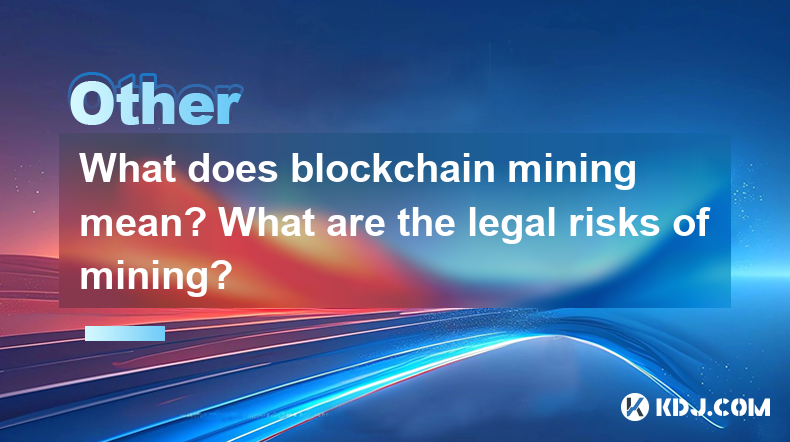
What does blockchain mining mean? What are the legal risks of mining?
Mar 31,2025 at 05:07pm
Blockchain mining is the process by which transactions are verified and added to the public ledger, known as the blockchain. Miners use powerful computers to solve complex mathematical problems, which, once solved, allow them to add a block of transactions to the blockchain. In return, miners are rewarded with cryptocurrency, typically Bitcoin. This pro...
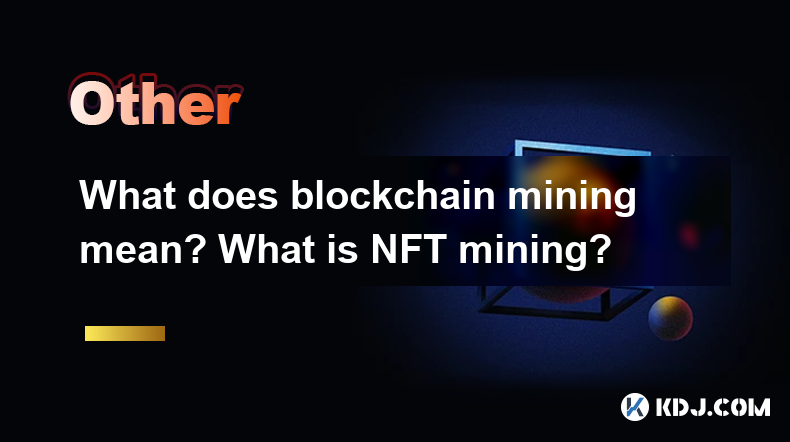
What does blockchain mining mean? What is NFT mining?
Mar 31,2025 at 04:07pm
Blockchain mining is a crucial process in the world of cryptocurrencies, particularly for networks like Bitcoin and Ethereum. It involves verifying transactions and adding them to the blockchain, a decentralized ledger. Miners use powerful computers to solve complex mathematical problems, which, when solved, allow them to add a block of transactions to ...
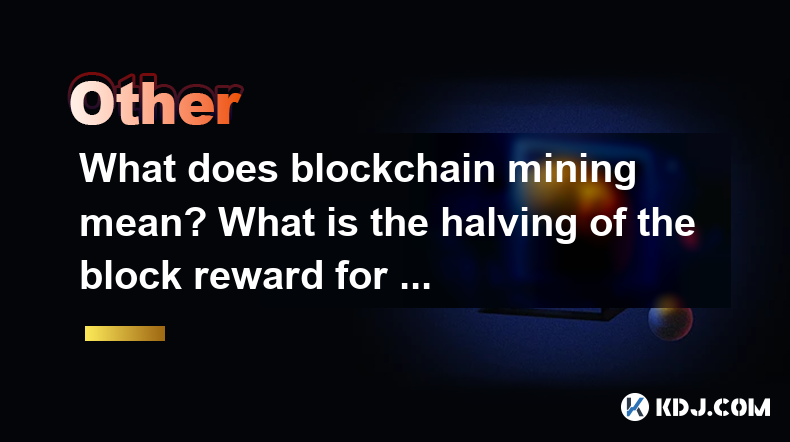
What does blockchain mining mean? What is the halving of the block reward for mining?
Mar 31,2025 at 03:43pm
Blockchain mining is a crucial process in the world of cryptocurrencies, particularly for networks like Bitcoin. It involves solving complex mathematical problems to validate transactions and add them to the blockchain, a public ledger of all cryptocurrency transactions. Miners use powerful computers to compete in solving these problems, and the first t...

How to view cryptocurrency quotes on your computer?
Mar 31,2025 at 02:10pm
The best cryptocurrency market viewing tools and methodsMany software and websites can help you track cryptocurrencies. Which tool to choose depends on your needs and technical level. From simple price tracking to advanced chart analysis, there are many options. Here are some popular options: Web application: Many exchanges offer free web-side market vi...

The relationship between block browsers and decentralized applications
Mar 30,2025 at 07:35pm
Understanding the InterplayBlock browsers and decentralized applications (dApps) share a symbiotic relationship within the cryptocurrency ecosystem. Block browsers act as crucial tools for interacting with and monitoring the blockchain, while dApps leverage this underlying blockchain infrastructure to provide their functionality. This interplay is esse...
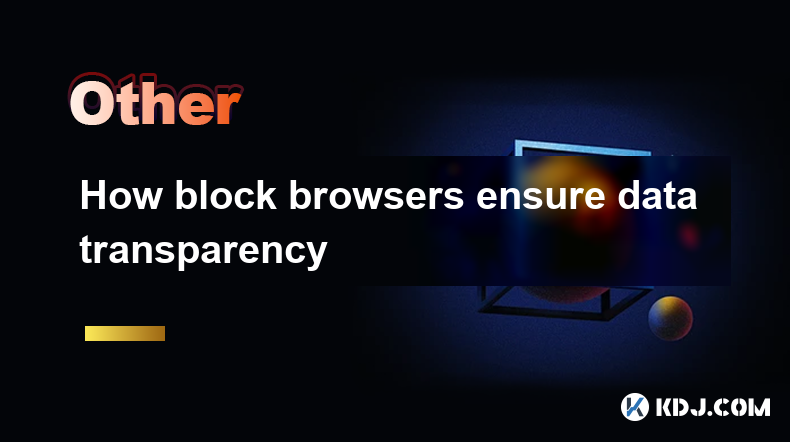
How block browsers ensure data transparency
Mar 30,2025 at 06:49am
Block browsers are designed to provide a transparent view into the inner workings of blockchain networks. Unlike traditional browsers that primarily access centralized servers, block browsers interact directly with the decentralized ledger, offering users a window into the immutable record of transactions. This transparency is a cornerstone of blockcha...

What does blockchain mining mean? What are the legal risks of mining?
Mar 31,2025 at 05:07pm
Blockchain mining is the process by which transactions are verified and added to the public ledger, known as the blockchain. Miners use powerful computers to solve complex mathematical problems, which, once solved, allow them to add a block of transactions to the blockchain. In return, miners are rewarded with cryptocurrency, typically Bitcoin. This pro...

What does blockchain mining mean? What is NFT mining?
Mar 31,2025 at 04:07pm
Blockchain mining is a crucial process in the world of cryptocurrencies, particularly for networks like Bitcoin and Ethereum. It involves verifying transactions and adding them to the blockchain, a decentralized ledger. Miners use powerful computers to solve complex mathematical problems, which, when solved, allow them to add a block of transactions to ...

What does blockchain mining mean? What is the halving of the block reward for mining?
Mar 31,2025 at 03:43pm
Blockchain mining is a crucial process in the world of cryptocurrencies, particularly for networks like Bitcoin. It involves solving complex mathematical problems to validate transactions and add them to the blockchain, a public ledger of all cryptocurrency transactions. Miners use powerful computers to compete in solving these problems, and the first t...

How to view cryptocurrency quotes on your computer?
Mar 31,2025 at 02:10pm
The best cryptocurrency market viewing tools and methodsMany software and websites can help you track cryptocurrencies. Which tool to choose depends on your needs and technical level. From simple price tracking to advanced chart analysis, there are many options. Here are some popular options: Web application: Many exchanges offer free web-side market vi...

The relationship between block browsers and decentralized applications
Mar 30,2025 at 07:35pm
Understanding the InterplayBlock browsers and decentralized applications (dApps) share a symbiotic relationship within the cryptocurrency ecosystem. Block browsers act as crucial tools for interacting with and monitoring the blockchain, while dApps leverage this underlying blockchain infrastructure to provide their functionality. This interplay is esse...

How block browsers ensure data transparency
Mar 30,2025 at 06:49am
Block browsers are designed to provide a transparent view into the inner workings of blockchain networks. Unlike traditional browsers that primarily access centralized servers, block browsers interact directly with the decentralized ledger, offering users a window into the immutable record of transactions. This transparency is a cornerstone of blockcha...
See all articles






















































































